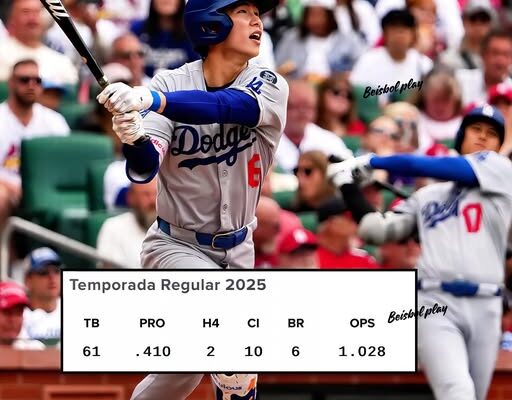Hyeseong Kim is a 26-year-old (born January 27, 1999) South Korean professional baseball player who signed with the Los Angeles Dodgers for the 2025 season. He primarily plays second base, shortstop, and center field, showcasing remarkable versatility. Before joining the Dodgers, he had a highly successful career in the KBO League (Korean Baseball Organization) with the Kiwoom Heroes from 2017 to 2024. In the KBO, he was known for his consistent hitting (a career .304 batting average through 2024, including .326 in his final KBO season), speed (leading the KBO in stolen bases in 2021 with 46), and exceptional defense (winning four KBO Golden Glove Awards).
Hyeseong Kim wasn’t initially expected to be a major league regular for the Dodgers right away. He started the 2025 season in Triple-A with the Oklahoma City Comets to adjust to North American baseball. However, due to injuries to other key players like Tommy Edman and Teoscar Hernández, Kim was called up to the majors on May 3, 2025, and he has been making the most of his opportunity.
The core reasons Manager Dave Roberts wants to utilize him, and why you’re seeing him “seated there” (meaning, potentially in the lineup more often, or being eyed for key spots) are clear:
-
He’s Hitting! His offensive numbers since his MLB debut have been incredibly impressive, especially considering he’s a rookie. Through early June 2025, Hyeseong Kim is batting .391 with a .435 OBP and a .563 SLG, resulting in a stellar .997 OPS over 64 at-bats. These are not just “good” numbers; they are elite. When a player, especially a rookie, comes up and performs at that level, a manager simply cannot ignore it. He has demonstrated an ability to put the ball in play, get on base, and even hit for some power (2 home runs, 3 doubles, 1 triple in limited at-bats).
-
Left-Handed Hitter (with good numbers against lefties): This is the crucial point you highlighted. The Dodgers, like many teams, constantly look for ways to optimize their lineup against different pitching matchups. If they have starting players who are struggling, particularly against right-handed pitching, a left-handed hitter like Kim offers a valuable alternative to balance the lineup and exploit matchups. While Roberts has been hesitant to give Kim many at-bats against left-handed pitchers early on (as seen when he pinch-hit Kiké Hernández for Kim against Adrian Morejon despite Kim already having a double against a lefty), Kim’s limited sample size against southpaws has actually been excellent (3-for-3 against lefties, including a home run and a double). This performance against left-handers, even in a small sample, directly contradicts Roberts’ initial caution and gives him strong statistical leverage to argue for more playing time in those situations.
-
Defensive Versatility: Beyond his bat, Kim brings exceptional defense and versatility. He can play multiple positions in the infield (second base, shortstop) and outfield (center field). This flexibility is incredibly valuable for a manager like Roberts, allowing him to rest regular starters, make defensive substitutions late in games, and adjust the lineup based on various scenarios. Dodgers manager Dave Roberts has specifically lauded Kim’s defense, even stating that Kim “can certainly win ballgames with his defense alone.” This defensive prowess ensures he adds value even when his bat isn’t scorching hot.
-
Speed and Baserunning: Kim is also a threat on the basepaths. He had 6 stolen bases without being caught stealing in his initial MLB stint, reflecting his KBO history as a stolen base leader. His speed adds another dimension to the Dodgers’ offense, creating pressure on opposing pitchers and fielders.
-
Addressing Underperforming Starters: You mentioned “starting players who aren’t performing up to par.” This is a reality in any long baseball season. While the Dodgers have a star-studded lineup, individual players can go through slumps. Michael Conforto, for instance, has been cited as a struggling veteran whose playing time could potentially be decreased to accommodate Kim’s hot bat. When a player like Kim, who was initially viewed as a utility or depth option, produces at an All-Star level, he forces the manager’s hand. Roberts faces the pleasant dilemma of having a high-performing player who demands more playing time.
The “hesitation” from Dave Roberts in fully unleashing Hyeseong Kim against left-handed pitching, despite the excellent numbers, is a common managerial approach, especially with rookies transitioning from foreign leagues.
- Sample Size: While Kim’s numbers against lefties are phenomenal, the sample size is very small (3-for-3). Managers often prefer to see a larger body of work before making significant lineup changes based on splits. They want to ensure the success isn’t just a fluke against particular pitchers or specific situations.
- Trust in Veterans/Established Players: Roberts has established players like Kiké Hernández and Miguel Rojas who can also play multiple positions and have track records in MLB. Even if their numbers against lefties aren’t currently stellar, managers sometimes stick with established players in familiar roles, hoping they will break out of slumps. Roberts specifically mentioned wanting to give Hernández opportunities to “get better versus left” and keep him involved.
- Protecting the Rookie: Sometimes, a manager might limit a rookie’s exposure to the toughest matchups (e.g., hard-throwing left-handed relievers) to help them build confidence and avoid putting them in situations where they might struggle and get discouraged.
- Long-Term Development: The Dodgers are known for their patient approach to player development. They might want to ensure Kim continues to refine his approach against different types of pitching, even if it means not playing him every single day against every single arm.
However, the consistent high-level performance from Hyeseong Kim is making it increasingly difficult for Roberts to keep him on the bench. As the article you likely pulled from suggests, Kim’s performance “certainly helps his case” for more playing time, and he is “making it impossible to ignore him.” His ability to deliver in crucial moments, like hitting a game-tying double off a left-handed pitcher, provides concrete evidence that he can indeed “solve that issue” of needing a reliable left-handed bat.
In essence, Hyeseong Kim is “seated there” (in a prominent position on the depth chart and increasingly in the lineup) because he has earned it with his outstanding performance across multiple facets of the game – hitting, defense, and baserunning – making him an undeniable asset for a Dodgers team that is always looking for an edge in its pursuit of a championship. His presence offers a dynamic solution to offensive struggles and defensive needs, proving to be far more than just a replacement player.



